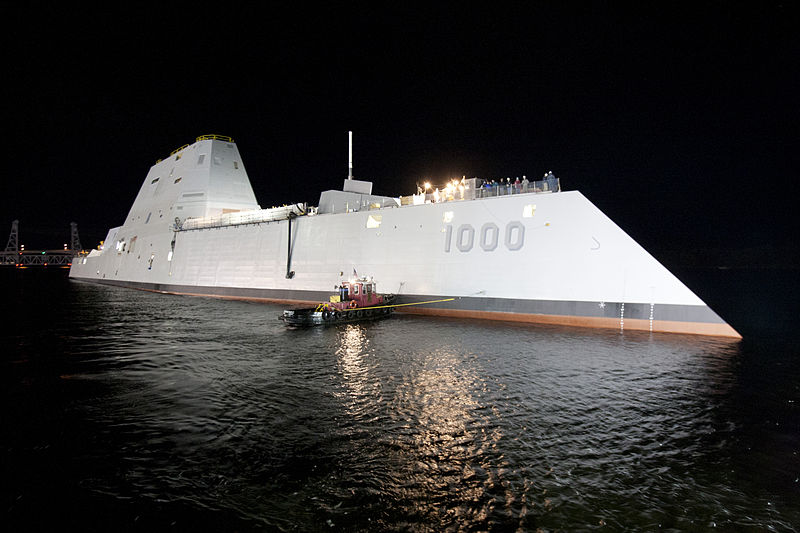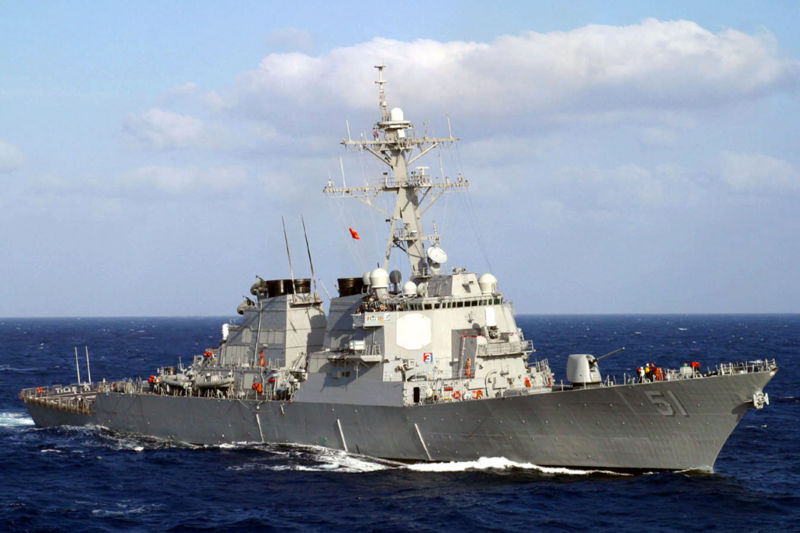It’s still the largest navy in the world, and will continue to be for some time yet … but it’s shrinking.

BATH, Maine (Oct. 28, 2013) The Zumwalt-class guided-missile destroyer DDG 1000 is floated out of dry dock at the General Dynamics Bath Iron Works shipyard. The ship, the first of three Zumwalt-class destroyers, will provide independent forward presence and deterrence, support special operations forces and operate as part of joint and combined expeditionary forces. The lead ship and class are named in honor of former Chief of Naval Operations Adm. Elmo R. “Bud” Zumwalt Jr., who served as chief of naval operations from 1970-1974. (U.S. Navy photo courtesy of General Dynamics/Released)
In 2009 the navy decided it could only afford to build three of the new DDG-1000s. To replace the cancelled DDG-1000s the navy resumed building older DDG-51 Arleigh Burke class destroyers. It was all about cost. The DDG-1000s would cost more than $3.5 billion each if built in large quantities. The Burkes cost $1.9 billion each. The last of 62 original Burkes was ordered in 2002 and the last of those entered service in 2011. But now, another 13 are on order and more were going to be ordered until the shrinking naval budget got too tight for that. The 9,800 ton Burkes are smaller than DDG-1000, being 154 meters (505 feet) long and 20 meters (66 feet) wide. But even the Burkes have been growing, with the first ones weighing in at only 8,300 tons. In 1945, most destroyers were about 3,000 tons. This constant size escalation is something navies, especially the Americans, have had a hard time dealing with, mainly because the cost per ton has escalated even more (even after taking inflation into account).
While the DDG-51 is much less expensive than the DDG-1000, some navy officials believe that in the long run the larger and more expensive DDG-1000 would be a better investment. The key problem here is the inability of the navy to control costs, and cost estimates, and the inability of the DDG-51s to provide space for new technologies. The navy hopes to overcome this by installing smaller versions of new tech in the DDG-51s and to upgrade other DDG-51s if the new stuff works out.
There are other problems as well, such as the costs of upgrades. Because of budget cuts the navy plans to buy some time (about a decade) by upgrading dozens of existing destroyers and cruisers. This is a bitter pill to swallow, as only a decade ago the navy was so sure about the new DDG-1000 that it accelerated the retirement of a dozen of the 31 Spruance class destroyers, in order to save the $28 million a year it would cost to keep each one of them in service. These ships were not just retired, they were all either broken up or sunk in training exercises. The dozen that entered service in 1979-83 could have been refurbished and been available until 2019. That’s a lost opportunity.

The guided missile destroyer USS Arleigh Burke (DDG 51) steams through the Mediterranean Sea. U.S. Navy photo by Journalist 2nd Class Patrick Reilly. (RELEASED)
In the end these extensive refurbishments were too expensive and the navy was forced to fall back on a two-tier refurb plan that concentrated on electronic and software systems. The cheaper tier, called MILSPEC (designed specifically and only for military use) cost $113 million and takes six months per ship. This upgrades a lot of the 1980s electronics in the older DDG-51s. The other tier, COTS (commercial off-the shelf) uses commercial hardware and software to replace the older MILSPEC stuff. This makes these ships easier and cheaper to continue upgrading but all this costs $184 million and 18 months per ship. All these upgrades concentrate on the ability of DDG-51s to support the Aegis modification that enables missiles and low orbit satellites to be shot down. There is additional money (from outside the navy budget) available to do this.
The navy is still in danger of losing (to retirement because of aging and failing systems) the oldest DDG-51s if money is not available to refurbish elderly hulls and mechanical equipment. Because of the unpredictable future budget the navy also has to make plans for some radical downsizing. If the money is not there, neither are the ships and prudent admirals have to plan accordingly.



